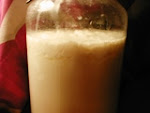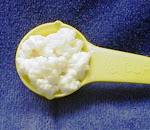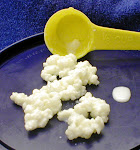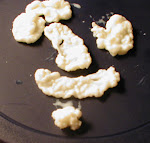Visit My Website and Virtual Store http://www.bacteriapimp.com
Probably the best place to acquire kefir grains (if not from a friend) is on eBay. Websites off eBay are very expensive. There is a lot of competition between sellers on eBay and that keeps the price way down much cheaper than private websites and still of comparable quality.
First you must decide how much kefir you need and how fast do you want it. For milk kefir it is probably best to do USPS Priority Mail but Fist Class is ok too. Kefir generally brews at a 10 to 1 ratio of milk to grain volume but the grains will grow until you can supply the whole world. The sellers sell between one single grain up to as many cups of the stuff you might want. Just remember to multiply the volume of what the seller is selling by 10 and that is how much kefir you can brew until the grains grow. Don’t necessarily believe everything the seller tells you because the seller may just be as incompetent or dishonest as any one else trying to sell you something.
Anyone can sell kefir on eBay. They don’t need a license or a degree. They don’t have to be honest, they don’t have to know simple math. They don’t have to be accurate in their knowledge of kefir. Who’s gonna know. Most people buying kefir are people buying it for the first time and most of us went to public schools, how many of us know how many ounces are in a third of a cup? Let see an eighth of a cup is an ounce and a quarter of a cup is two ounces so a third of a cup is 3 ounces right? Wrong. A third of a cup is 2.66 ounces. I didn’t know that I’ve been around a long time.Some sellers on eBay sell spoonfuls and some also sell heaping spoonfuls.
They tell us that their spoonfuls will ferment so much milk. Actually the smallest grain of kefir will ferment a million gallons of milk…..eventually. By the way there are 3 teaspoons in a tablespoon, 2 tablespoons in an ounce. I don’t know how big these sellers spoonfuls are only they know. I like to know if I am buying something. I like to know what I am buying.Some sellers advertise large mother grains. You won’t get a batch of all male non reproducing grains as the grains are neither male nor female and there is no mating season for kefir grains, most healthy active grains will be reproducing, The large grains are actually less active than small ones being that they have less surface area they are then less effective and need to be pulled apart by your washed clean fingers.Some sellers suggest you use nylon or plastic pouches and that you will save time and effort because you can wash the pouch with water cleaning the grains at the same time. These are serious and dangerous pieces of misinformation. Kefir is very alkaline that is why it is so effective against things like acid reflux that is why it can survive the bile and stomach acids that will destroy capsuled concentrated drug company kefir strains. Kefir is so alkaline it will not only dissolve plastic and nylon but it will dissolve metal. If you put plastic in your fermenting kefir you will end up drinking plastic or nylon. If your kefir splashes against a metal lid it will begin dissolving the lid and the next time you splash the lid you will bring back to the drink those elements that have been dissolved.
Some sellers suggest cotton and hemp pouches but these pouches are wonderful places for bacteria to grow and hide don’t use them but if you must be sure to boil them between brewing cycles. Don’t be lazy, don’t use pouches. Use a soft mesh plastic strainer. The plastic strainer does not stay in contact with the kefir long enough to begin to dissolve and it should be well wash after it is used and it should be used only for this purpose. When working with bacteria it is a good idea to keep the utensils used for that purpose separate as special bacteria utensils. When washing your kefir utensils use very hot water and then rinse right away in very cold water, remember the same hot water that kills bacteria becomes as it cools a very happy place for bacteria as they like warm but they don’t like very hot or very cold, to them warm is cozy.. Get all the soap out and towel dry. Kefirs are very sensitive to residueSome sellers suggest you wash your grains with water after each cycle but they never say why or what exactly the purpose is but I figured out why they never say why and the reason is there is no good reason (except for just before you dehydrate your grains) These sellers just are not knowledgeable of kefir.
If someone thinks I am wrong about this or if someone has a reason to wash grains in water please let me know. When you do wash your grains with water or even milk for that matter you are washing away defensive kefir strains whose job on the grains is to defend against invading foreign bacteria, if they are washed away they can not do that job.Some sellers say they will send you a cup of starter plus grains. Can someone tell me what kefir starter is? I know they sell a packets of starter they call kefir that contain kefir grains but these packets only are good for 7 or 8 fermentations, is that what the seller is selling? In yogurt, starter is part of the last batch used to make the next batch but that does not exist in kefir. Part of the last batch in kefir is a good addition when you make your next batch because it offers comfort to the grains as they go into fresh milk, the last batch addition is the same ph level as the grains and insulates the grains from the new milk until they can start to readjust but when transporting kefir it is better to send them in new milk because new milk will last longer to moisten and feed the grains during their postal trip. If I was buying grains I would want to know once again, exactly how much grains am I getting?
Some sellers don’t mention how the will be shipping, some say they will ship the standard shipping method. The standard shipping method is a flat rate for all buyers no matter where they live; however, a standard shipping method if not further described means the seller may send at any method he chooses and you will not know what that is until you receive you item. Unless the seller says he is sending first class or priority mail or whatever he has no responsibility to you as to how he sends your item. If a seller is shipping at 6.50 at the standard shipping method and you get your package a week and a half later you cannot complain because that is often how long Parcel Post or first class takes at the USPS. I’m paying good money for my item and I want to know how it will be shipped, if I can’t see the amount of grains being sold and for how much and by what method it is being shipped in the first 2 minutes after looking at the item's description I would be wary.
One seller says he will send the grains either first class or priority mail depending on the weight. What does that mean? It means he will send your grains first class and pocket the rest of the money that is what that means.Some sellers say their grains sold on eBay are organic, I have not seen any certified organic grains on eBay, they are only claimed to be organic as no one tells of their certification. They may be organic but then again they may not be. There are some websites offering certified organic grains with seals of certificates but they are about 4 times as expensive. When you get your grains and put them in organic milk they will then be organic.Some sellers claim their grains are better because they come from some far off place, for the most part all kefir grains are equally excellent grains all coming from the same source. If you and your neighbor order the same grains 6 months later the makeup of your grains may be different than his as the grains change but basically they will be the same as will all kefir grains in the world. They all evolved from the same source and they are all basically made up of the same bacterial composition with only minor differences. There are some grains from Russia from around the Cherynoble area that glow in the dark and I would warn against that if you see that occurrence. If some seller tells you his grains are better than other grains and that is why he is selling them for more money I would think twice before swallowing that line.
One seller insists that his flat grains are a rare form of kefir. Flat or stringy grains are a natural occurrences in brewing and they eventually go back to their normal round shape if given enough room in a large enough container and if they are mixed enough. Flat grains are not a rare form of kefir that make a special kefir, think about it does that make sense to you? That is a falsehood, just as purple water kefir is not a rare form of water kefir, and purple kefir comes from brewing in grape juice and can be accomplished in one fermentation of grape juice. Don’t be fooled
Here is a conversion chart to help in determining what grains will do and what they won’t do
1. One teaspoon is a third of a tablespoon, yes, 3 teaspoons are needed to make a tablespoon, and I didn’t know that.
2. One tablespoon is half an ounce, that’s right 2 tablespoons make a full ounce and 6 teaspoons make an ounce. It’s true, I checked it.
3. Eight ounces make a cup, so 16 tablespoons make a cup and 48 teaspoons make a cup
4. 4 cups make a quart which is also 32 ounces and 64 tablespoons equal 4 cups and also make a quart and a whopping 192 teaspoons make a quart. and 192 teaspoons also make 4 cups.
5. 2 quarts make a half gallon and 4 quarts make a gallonWhy is this important; well, kefir is being sold in increments of; a spoonful, a teaspoon, a tablespoon, an eighth of an ounce, half of an ounce and sometimes the amount of kefir is not mentioned at all but instead the buyer is told a figure of how much milk may be fermented with what is being sold. Let’s see how these increment amounts can be used
Kefir grains are generally used to ferment milk at a ratio of between 7 parts milk to 1 part grains but there are no real rules and many ferment with ratio’s all the way up to 12 parts milk to 1 part grains and you could ferment at a ratio of 20 to 1 and beyond but lets use the figure 10 parts to 1 part just to have easier math because once again we don’t want to maybe get a headache.At 10 to 1 a teaspoon of grains will ferment 10 teaspoons of milk, 10 teaspoons of milk is also 3.3 tablespoons which is also 1 and 2/3 ounces. Get it? A teaspoon of grains will ferment 1 and 2/3 ounces of milk not a few cups as a few sellers claim.At the 10 to 1 ratio a tablespoon of grains will ferment 10 tablespoons of milk or 5 ounces
At the 10 to 1 ratio an ounce or 2 tablespoons will ferment 10 ounces which also equals 1 cup plus 2 ounces or 1 cup plus a quarter of a cup.So if a seller says he will sell you enough grains to ferment a cup or a few cups, (there are generally 3 units in a few) a quart or 32 ounces of milk, we don’t know what he is talking about or what he is selling; not really, maybe he doesn't either maybe even more freighting he does know. If I was buying grains I would like to know exactly what I was getting for my money.













No comments:
Post a Comment